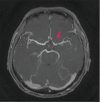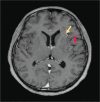Neurosyphilis presenting as acute ischemic stroke
- PMID: 31941739
- PMCID: PMC6964169
- DOI: 10.7861/clinmed.2019-0368
Neurosyphilis presenting as acute ischemic stroke
Abstract
Neurosyphilis is a broad term used to describe an infection caused by Treponema pallidum in the central nervous system. While this was a common cause of stroke in the 19th century, it saw a decline after the introduction of penicillin. However, in the recent past, there has been an increase in the incidence of syphilis, especially with HIV coinfection. Neurosyphilis results from an untreated primary syphilis. Neuropsychiatric disorder appears to be the commonest manifestation followed cerebrovascular accident, myelopathy, ocular disease and seizure. Known as the 'great imitator', this entity, however, may be easily missed if not for a high index of suspicion. This is especially so because of its similar presentation to other more common clinical conditions. We describe the case of a 39-year-old man displaying acute global aphasia and right-sided facial weakness in keeping with a left middle cerebral artery infarct. This was confirmed with computed tomography of the brain, and subsequently, further investigations revealed a diagnosis of neurosyphilis. The patient was treated with intravenous benzylpenicillin and recovered well with treatment.
Keywords: MRI; Meningovascular syphilis; arteritis; stroke.
© Royal College of Physicians 2020. All rights reserved.
Figures



Similar articles
-
Meningovascular Syphilis: A Case of a Young Man Presenting With Acute Stroke and Pulmonary Emboli.Cureus. 2023 Sep 2;15(9):e44568. doi: 10.7759/cureus.44568. eCollection 2023 Sep. Cureus. 2023. PMID: 37790000 Free PMC article.
-
Ischaemic apoplexy caused by syphilis.Ugeskr Laeger. 2024 Jul 8;186(28):V01240040. doi: 10.61409/V01240040. Ugeskr Laeger. 2024. PMID: 39115231 Danish.
-
Neurosyphilis presenting with a stroke-like syndrome.BMJ Case Rep. 2015 Mar 4;2015:bcr2014206988. doi: 10.1136/bcr-2014-206988. BMJ Case Rep. 2015. PMID: 25739793 Free PMC article.
-
Mesiotemporal changes on magnetic resonance imaging in neurosyphilis.Intern Med J. 2012 Sep;42(9):1057-63. doi: 10.1111/j.1445-5994.2012.02829.x. Intern Med J. 2012. PMID: 24020346 Review.
-
REVIEW: Neurosyphilis: A historical perspective and review.CNS Neurosci Ther. 2010 Oct;16(5):e157-68. doi: 10.1111/j.1755-5949.2010.00183.x. Epub 2010 Jul 8. CNS Neurosci Ther. 2010. PMID: 20626434 Free PMC article. Review.
Cited by
-
Novel and characteristic radiological features of neurosyphilis: a case series.BMC Neurol. 2024 Jul 20;24(1):248. doi: 10.1186/s12883-024-03762-5. BMC Neurol. 2024. PMID: 39033301 Free PMC article.
-
Neurosyphilis with sequential respiratory complications: A case report highlighting diagnostic and treatment challenges.SAGE Open Med Case Rep. 2024 May 29;12:2050313X241256825. doi: 10.1177/2050313X241256825. eCollection 2024. SAGE Open Med Case Rep. 2024. PMID: 38817409 Free PMC article.
-
Ischemic stroke as an initial presentation of neurosyphilis in a newly diagnosed HIV patient: A case report and literature review.Clin Case Rep. 2024 May 10;12(5):e8794. doi: 10.1002/ccr3.8794. eCollection 2024 May. Clin Case Rep. 2024. PMID: 38736579 Free PMC article.
-
Neurosyphilis: insights into its pathogenesis, susceptibility, diagnosis, treatment, and prevention.Front Neurol. 2024 Jan 11;14:1340321. doi: 10.3389/fneur.2023.1340321. eCollection 2023. Front Neurol. 2024. PMID: 38274871 Free PMC article. Review.
-
Meningovascular Syphilis: A Case of a Young Man Presenting With Acute Stroke and Pulmonary Emboli.Cureus. 2023 Sep 2;15(9):e44568. doi: 10.7759/cureus.44568. eCollection 2023 Sep. Cureus. 2023. PMID: 37790000 Free PMC article.
References
-
- Wong W, Chaw JK, Kent CK, Klausner JD. Risk factors for early syphilis among gay and bisexual men seen in an STD clinic: San Francisco, 2002-2003. Sex Transm Dis 2005;32:458–63. - PubMed
-
- Golden MR, Marra CM, Holmes KK. Update on syphilis: resurgence of an old problem. JAMA 2003;290:1510–4. - PubMed
-
- Mattei PL, Beachkofsky TM, Gilson RT, Wisco OJ. Syphilis: a reemerging infection. Am Fam Physician 2012;86:433–40. - PubMed
-
- Chahine LM, Khoriaty RN, Tomford WJ, Hussain MS. The changing face of neurosyphilis. Int J Stroke 2011;6:136–43. - PubMed
Publication types
MeSH terms
LinkOut - more resources
Full Text Sources
Medical
Miscellaneous

